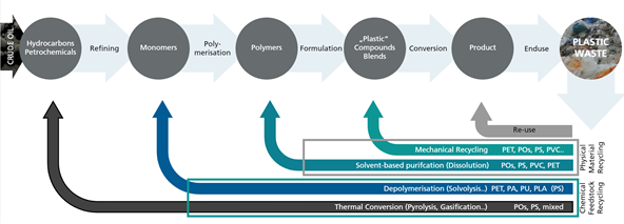Many of us in the US dutifully recycle plastic, glass, and cardboard containers. More of us still participate in bottle redemption programs if they’re available where we live, although we still have a long way to go.
The sad truth is that although many people in the US participate in recycling programs, the vast majority of recyclable materials in the US still end up in landfills. This is in part because, in the US, there are no laws as there are in the EU that mandate recycling rates. In the US, recyclable materials are only processed when the market price of the recyclates makes it profitable to do so. Otherwise, the materials returned for recycling are landfilled or incinerated.

Plastic Waste Disposal in the US, 2018 As you can see, we still have a long way to go. (Source US GAO).
Since, for the time being, the US relies on market forces to drive closing the loop between what is placed in a recycling bin and what is turned into new products, methods, and technologies that make recycling more efficient and that produce higher-value materials can go a long way to increasing our actual recycling rates.
EREMA leads the world in plastics recycling technology. The market space that we currently occupy is Mechanical Recycling. Our systems utilize mechanical and thermal methods to shred plastics, melt them, strip them of contaminants and process them into usable pellets. In order for our systems to work effectively and efficiently, the plastics being processed need to be sorted into their material types. This takes some type of sorting process. Advances in using AI and robotics to more efficiently sort plastics into common types hold the promise of increasing recovery rates and reducing processing costs.
Introducing new recycling technologies can broaden the range of plastics that can be effectively recycled. A technology on the horizon is Chemical Recycling. Chemical recycling uses heat and chemical reactions to break down plastics into something close to their original component feedstocks. While initially it was presumed that a mix of plastics could be chemically recycled without the need for sorting, in practice, chemically recycling mixed plastics is impractical. Chemical recycling then is not a panacea to streamline recycling processes, but rather an enhancement, extending the ability of more types of plastics to be recycled, those that are not amenable to mechanical recycling.
Until the US regulatory environment catches up with the reality of the unsustainable way in which we waste valuable reusable resources the way to increase plastic recycling efficiency, and therefore lower costs and make it more widely practiced in the US is to look at the entirety of what a closed-loop system would look like.
In the recent article How can mechanical and chemical recycling work together in practice? Clemens Kitzberger & Klaus Lederer of EREMA Group point out that a primary driver of structuring efficient plastic recycling systems is to retain as much of the energy that was used to create the plastic as possible in the product being recycled.
The further that plastic goes back toward the origin of its production process, the more energy is lost, and the more economic value needs to be made up in reprocessing.

The key to managing this value chain is Design for Recycling. By designing end products that take recycling into account, less post-consumer processing is required, and costs to make a usable recyclate are lower. You can learn about products that have incorporated a Design for Recycling approach here.
The article goes further into the details of what Design for Recycling entails with various types of plastic film products which you can read here.














